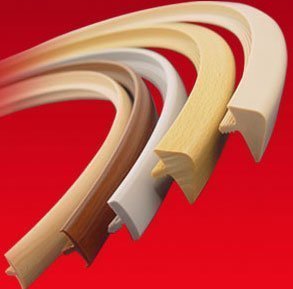PVC edge banding is made of polypropylene or polyvinyl chloride, mechanically pressed wood grain, transparent, plain, two-color series of plastic edge banding. It has the characteristics of heat resistance, oil resistance and strength, hardness and high bendability; its surface properties are good, wear-resistant and can be repaired; the surface effect is also good, its pattern and color can be close to the natural wood color of the log, or there are Other color patterns; PVC edge banding with a textured or coated finish on the underside is also very good. Its specifications: thickness of 0.2 ~ 3mm, width of 19-50mm, length of 1000mm a roll. PVC edge banding has a certain thickness of 2mm or more. It must be heated to soften or increase the temperature of the adhesive during use. Otherwise, it will fall off due to the stress sticking. According to industry experts, PVC edge banding is prone to problems such as insufficient stability, foaming and aging.

There are several reasons for the lack of thermal stability of PVC edge banding
1. The heat stabilizer is unqualified or improperly selected;
2. Insufficient amount of heat stabilizer;
3. The setting of processing temperature is unreasonable, mainly because the temperature is too high;
4. The screw speed of the extruder is too fast;
5. The matching or dosage of the internal and external lubrication of the formulation system is unreasonable;
6. The main raw materials such as PVC itself are not stable enough. In addition, reasonable mixing processing conditions will greatly reduce the impact of volatile components in the raw materials.
Analysis of the causes of foaming of PVC furniture edge banding
1. Some of the raw materials are damp, and more volatiles will cause the PVC edge band to foam during the extrusion process.
2. Insufficient thermal stability leads to decomposition and foaming of PVC.
The main reason for the aging of furniture edge banding:
The photoaging cycle of PVC edge banding is longer under natural climatic exposure conditions. Therefore, in order to quickly evaluate and predict the light aging resistance of PVC materials, it is necessary to establish a artificial accelerated ultraviolet aging simulation experiment system to facilitate the shorter time. The experimental results were obtained to provide theoretical basis and basic data for evaluating and predicting the photo-aging resistance of PVC edge banding.
Whether in natural climate exposure or artificial ultraviolet acceleration, the temperature is always accompanied by the entire cycle of the test. As can be seen in Table 4-1, the surface temperature of PVC materials of different colors can reach 70 °C under illumination. The values of the parameters of the PVC edge banding under different temperature heating conditions changed after 168 hours, and the degree of change was greater at 60 °C and 80 °C.












